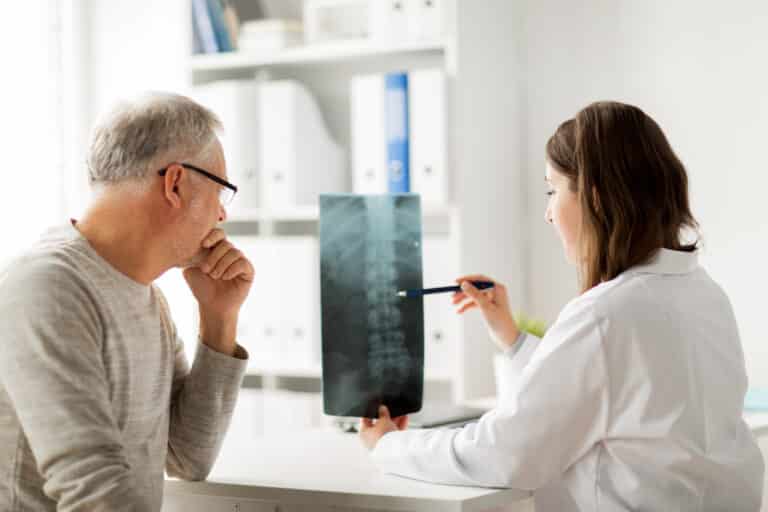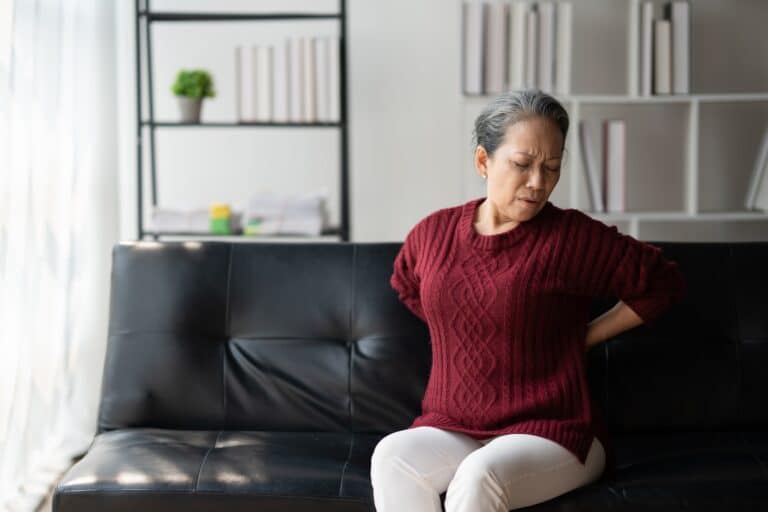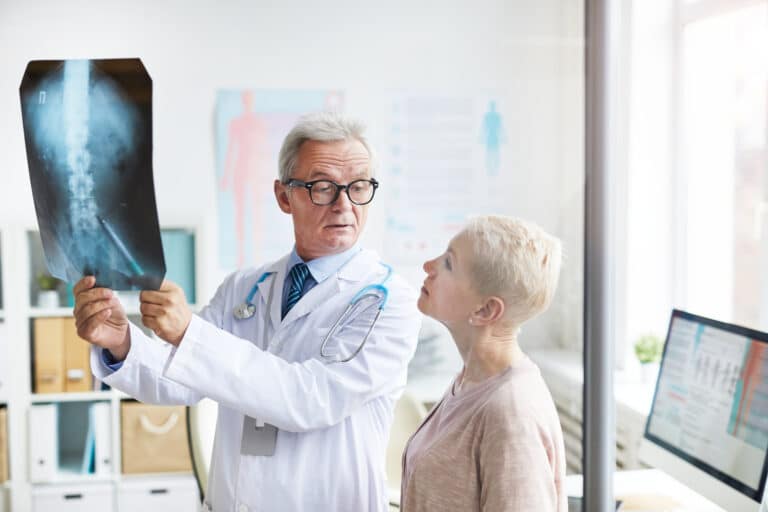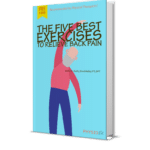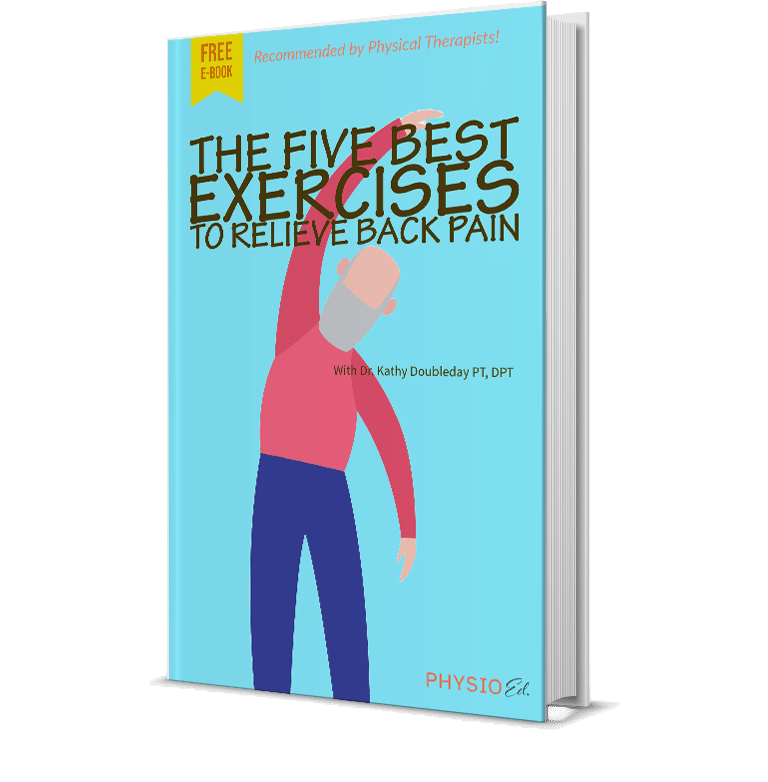A rounded back is an understandable concern for many older adults. While many seniors live with kyphosis or forward curvature of the upper spine, it is often a mysterious and poorly understood condition.
It can be helpful to understand the basics of kyphosis and its various causes, its symptoms and diagnosis, and the best treatment options for managing and preventing excessive curvature of the spine.
What is Kyphosis?
The words kyphosis and lordosis describe the natural curves in your spine.
There are three primary curves in your spine, two of which are in your lower back (the lumbar spine) and neck (the cervical spine)— called lordotic curves, and one in your upper back (the thoracic spine), called a kyphotic curve.
The terms convex and concave may prove helpful here. You can consider a lordotic curve a concave curvature (bowing inward), while a kyphotic curve is convex (bowing outward).
When viewed from the side, this natural spinal curvature creates a shallow S-shape from your skull to your hips.
The combination of lordotic and kyphotic curves in your spine is designed to create a neutral, upright posture that can handle stress in different positions and from different directions.
Generally speaking, kyphosis is a good thing because it plays an essential role in the structure and stability of your spine. However, it is possible to have too much of a good thing.
Kyphosis and Posture
testing editing revisions here
You might be familiar with kyphosis as it relates to posture, specifically “bad” or “poor” posture.
When you have small and proportional curves in your back, the result is a regular upright posture. However, when one curve is much steeper than it should be, it can negatively affect your posture. When the kyphotic curve in your upper back is excessively steep, it is called hyperkyphosis. (1)
Hyperkyphosis can create a forward, hunched posture or rounded back and shoulders, a common concern for many older adults. A rounded back shifts the weight of your upper body forward, making it more challenging to maintain a normal posture. This position can stress your neck and lower back — your lordotic curves — as they try to find a neutral position over your center of gravity. (1)
Rounded Shoulders, Function & Confidence
Hyperkyphosis can be challenging for reasons relating to both function and confidence.
Functionally speaking, a rounded upper back can make activities like reaching overhead more difficult. Conversely, many older adults feel less confident with a rounded back because they can’t walk tall or look others in the eye as easily.
In my experience working with patients, many older adults are embarrassed by their hyperkyphosis, even if it doesn’t significantly affect their daily activities.
With clients in my clinical practice, I have found it helpful to discuss the causes of kyphosis and how it relates to the natural aging process. Understanding this condition can help lessen the self-consciousness accompanying a rounded back.
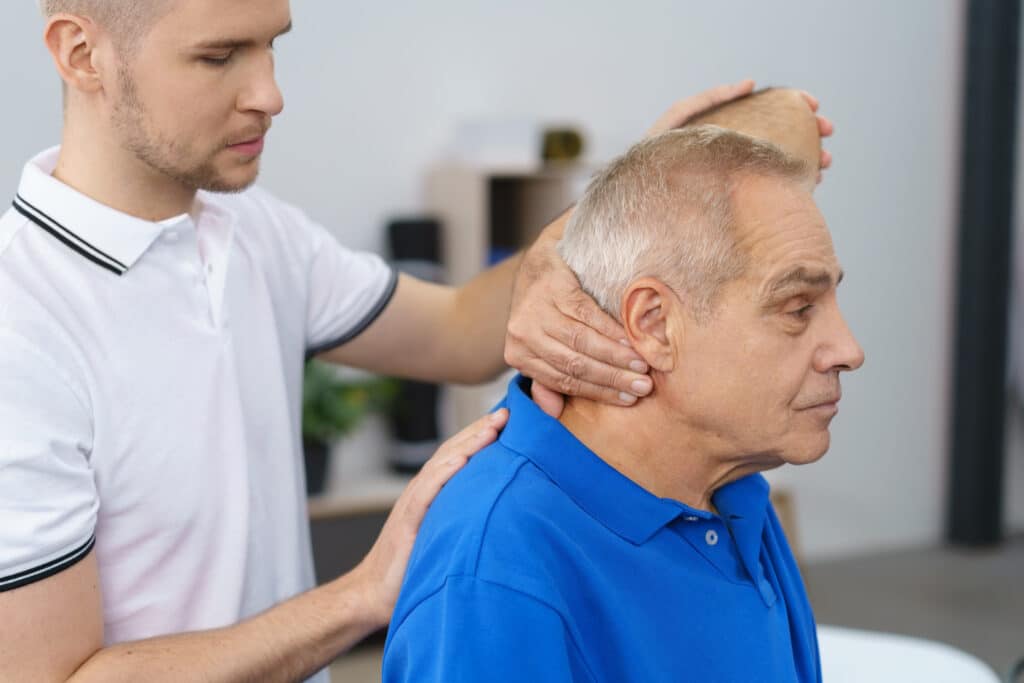
The Causes of Kyphosis
Kyphosis and lordosis can vary significantly from person to person, and many factors can affect how each curve develops. There are many types of kyphosis due to various causes.
Understanding what is “normal” and what’s not is essential to create a healthy relationship with the curvature of your spine. It’s vital to remember that kyphosis is a natural feature of your upper back that plays a critical role in the overall structure of your spine.
However, excessive kyphosis (hyperkyphosis) is not normal and can negatively affect your health.
Postural Kyphosis
Posture habits contribute to some of the most common causes of increased kyphosis.
When you sit with a hunched back, gravity applies more pressure on the front side of your spine. Over time, this can result in thinning of the intervertebral discs, which provide cushioning between the bones of your spine.
The result is less cushioning in the front of your spine, which pulls you into deeper kyphosis. (1)
Microfractures are tiny chips in the bones of your spine that can occur from repetitive stress. Microfractures are more likely to occur as kyphosis in your upper back progresses. More microfractures can result in the worsening of hyperkyphosis. (1)
Your doctor can identify these fractures on an X-ray, which can help identify the cause of your pain or discomfort.
Many other factors contribute to kyphosis and hyperkyphosis, including genetics, muscle imbalances, arthritis of the spine, scoliosis, and autoimmune conditions like ankylosing spondylitis. (1, 3)
Congenital kyphosis (including Scheuermann’s kyphosis) involves spinal deformity or kyphosis diagnosed earlier in life in which the spine fails to develop properly. This is unrelated to poor posture or other above causes.
Although it’s easy to get caught up on the exact cause of a rounded spine, it’s more important to find strategies to manage the condition and prevent future problems from developing.
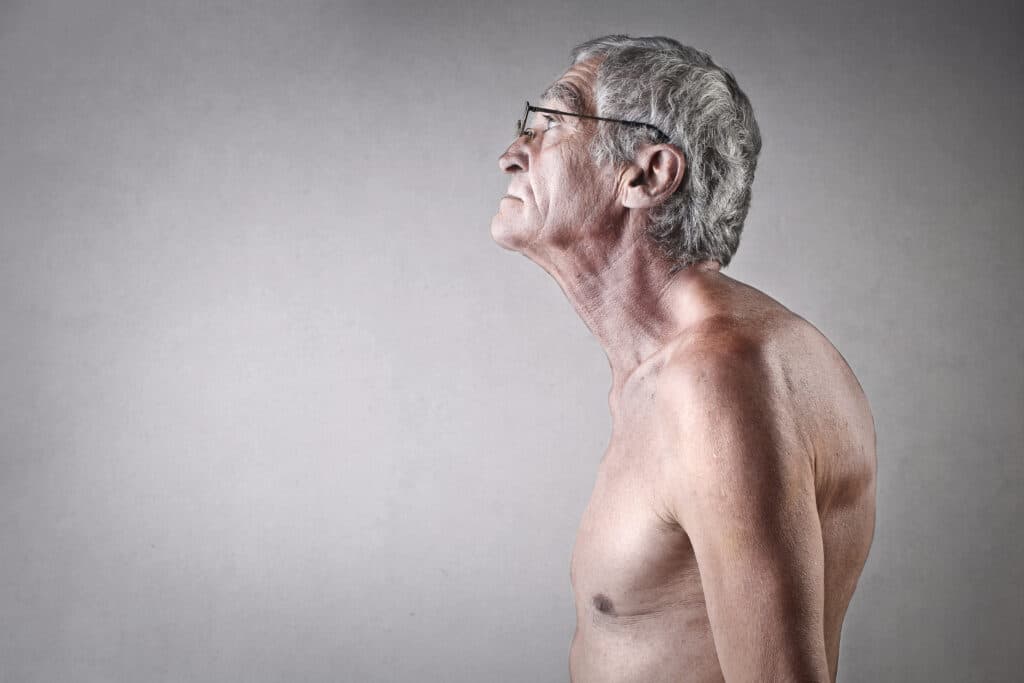
Kyphosis Symptoms and Diagnosis
Remember, some kyphosis is a normal feature of a healthy spine and shouldn’t cause concern. However, more significant degrees of rounding can have postural and functional symptoms.
The postural symptoms of excessive kyphosis are relatively simple and typically present as a “hunchback” or rounding forward of the upper back. In most cases, this causes significant leaning forward in your posture and increased difficulty standing up straight. (1)
This can also make the backside of the bones in your spine (called spinous processes) more visible and sensitive to pressure. In some cases, arthritis in the spine can make this condition worse.
Another important consideration with hyperkyphosis is an increased risk for falls. Many older adults rely on their balance to prevent falls when walking, going up and down stairs, and doing daily tasks.
Forward-rounded posture and difficulty standing up straight can affect balance for two reasons.
First, it changes your center of gravity, which makes maintaining and recovering your balance more challenging.
Second, it may affect your field of vision and force you to focus on your feet more.
Because vision is integral to balance, changing your visual input can make many older adults more prone to losing balance and falling.
In my practice and experience as a physical therapist, what I’ve found to be most important for my patients is recognizing the stage of kyphosis you’re living with, how it impacts your daily life, and what treatment options will be most effective for keeping you active over the long term.
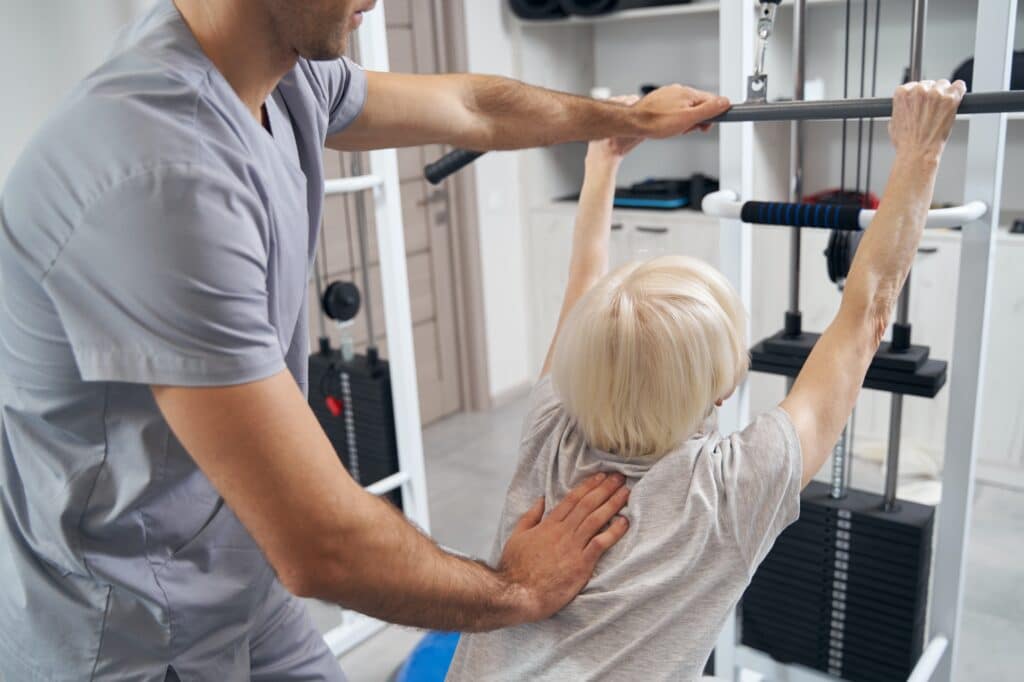
Kyphosis Treatments
Many treatment options are available for managing and limiting kyphosis, but knowing where to focus your self-care practice can be difficult. Two of the most effective methods to treat kyphosis involve attention to posture and targeted exercise.
Address Your Posture
Few things play as big of a role in kyphosis as your posture.
Put simply, when you sit and stand with an ideal posture, you are more likely to maintain a healthy curve in your upper back.
Conversely, when you constantly slouch throughout your day, you are more likely to develop an increased curve in your spine. This means that paying more attention to your posture might make the difference in slowing the progression of your kyphosis.
When your shoulders are constantly rounded forward, they put more stress on your upper back and neck, which causes more stress and rounding. Aligning your joints is an excellent approach to managing your posture throughout the day:
Create a straight vertical line from head to hips when sitting or standing by setting your upper back directly over your pelvis. From there, try to look straight ahead and bring your head directly above your shoulders to create a straight line from top to bottom. Think about trying to align your ears directly above your shoulders.
Throughout your day, try to gently pull your shoulders back to bring them directly alongside your upper back. Not only will this limit forward stress on your upper back, but it can also strengthen your back to help with standing and sitting up straight.
Surgery for Kyphosis
In some rare circumstances, surgery for severe kyphosis may be performed to prevent dangerous medical complications.
This is typically reserved for cases where kyphosis and osteoporosis co-occur and where conservative treatments such as a kyphosis brace have been unsuccessful. More drastic measures like spinal fusion may be called for in these severe cases but are typically not recommended for mild kyphosis. (1)
Exercise
Strengthening exercises for your back, shoulders, and neck can be some of the most effective options for kyphosis self-care.
When you spend time strengthening the muscles of your upper back and shoulders, it becomes easier to maintain an upright posture throughout your day. This can translate to more comfortable sitting, better walking balance, and more range of motion when reaching overhead.
Strengthening your neck muscles is also crucial for managing kyphosis; when you have a strong neck, you can more easily hold your head above your shoulders. Less forward positioning of your head means less stress on your upper back, making it even easier to sit and stand taller.
Physical therapy is also very helpful in addressing postural kyphosis or other conditions related to the spine.
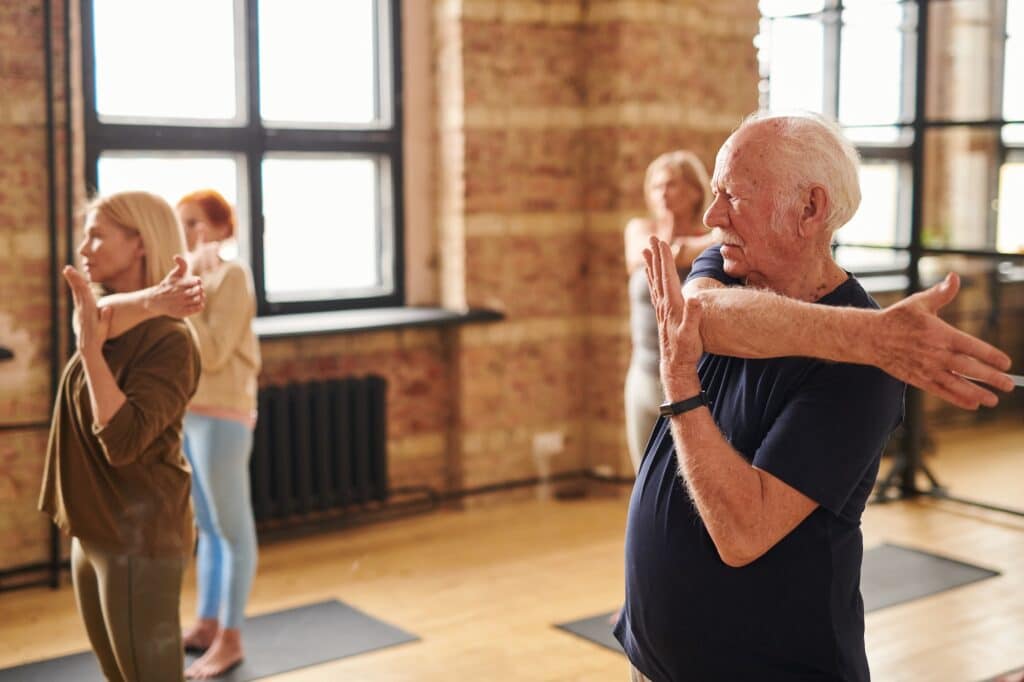
At-Home Exercises for Kyphosis
There are many exercises for older adults to choose from when it comes to strengthening your back for better posture. (2)
Let’s cover a few you can try at home without specialized gym equipment:
Shoulder Squeezes
Start by standing or sitting upright in a chair.
With your arms at your sides, gently squeeze your shoulder blades together by activating the muscles at the center of your upper back while trying to sit or stand tall. Imagine you are trying to hold a pencil between your shoulder blades to help squeeze as much as possible.
Briefly hold the position, then relax.
Repeat until your back feels fatigued and try to do this exercise a few times daily.
Chair Extensions
Start by sitting upright in a chair and interlacing your fingers behind your head.
With your back resting on the back of the chair, slowly bend your upper back over the back until you feel a stretch in your upper back.
Briefly hold the position, then relax and return to the start.
Repeat the movement about 10 times and try to do this exercise a few times daily.
Chin Tucks
Start by sitting upright with your hands on your thighs, and your face and shoulders relaxed.
Gently draw your chin backward, pause, and return to the start. This should feel like you are making a “double chin” but shouldn’t cause pain in your neck or head.
Make sure to look straightforward without tipping your head back. Repeat for 10-20 repetitions or until your neck becomes tired.
These exercises will get you started, but talk to your physical therapist about further exercises that favor your upper back and neck strength to improve posture.
Summary
How you look and feel can significantly impact your overall quality of life. A rounded upper spine can wear on both your tissues and confidence.
Dealing with a rounded back can be difficult, but understanding the details of kyphosis and how to manage it best can make a big difference in your daily life.
Although kyphosis is normal for many older adults, knowing the symptoms of excessive kyphosis can help you decide when to start addressing them to prevent further problems.
Simple strengthening exercises can play a big part in maintaining good posture and preventing pain over the long term.
Contact your doctor for more information if you have questions or concerns about your spine health, and consult with your local PT to build a comprehensive spinal wellness plan.



